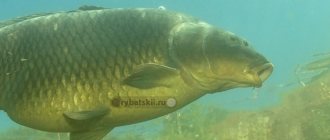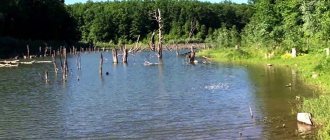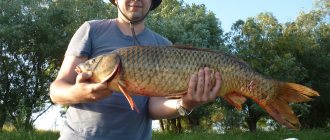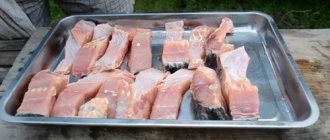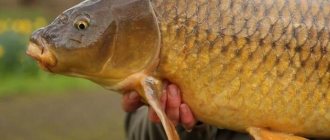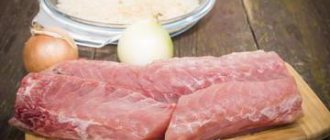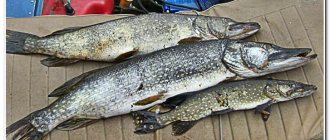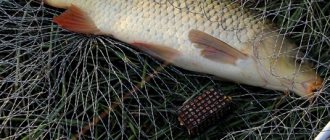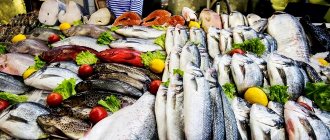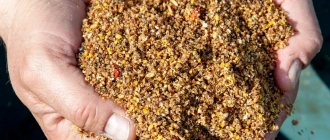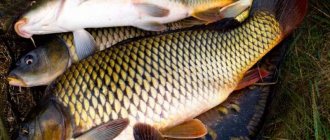Yuri 09/11/2020 551
Despite the variety of fishing gear used to catch carp, the fly-float fishing rod does not give up its position. Catching carp on a float gives this type of fishing a unique charm. Everything is fair here - the chances of winning in a confrontation between a fisherman and a carp are as equal as possible. Only knowledge, correctly chosen tactics and reliable equipment will help you get the desired trophy.
Not every angler comes to fishing with fly float tackle. Only when you have confidence in your own experience and skills do you have the desire to catch a cautious, powerful fish with a float rod. The emotions and impressions from such fishing are much brighter and remain for life.
Features of catching carp
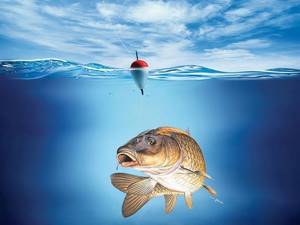
During these “travels” the fish acquires great strength and if the angler is too lazy, it is capable of tearing off the strongest gear with a powerful jerk. Catching carp is the cherished dream of most fishermen, and to achieve this dream they are capable of many sacrifices. Often, a carp session lasts for several days and does not always end in success. The fisherman needs not only to offer the fish his favorite delicacy, but also to attract it to the place where this delicacy is located.
Considering that the area of reservoirs in which carp live and are caught is very large, it is clear how difficult the task of attracting fish is. And there are many questions regarding the equipment used, because bottom carp rigs become useless when the carp is at half-water or loitering just under the surface of the reservoir. Temperature, pressure, and other factors affect the activity of wild carp and influence its choice of stopping place for feeding or resting.
Carp anglers try to catch carp in mid-water or from the surface using a zig-rig, but in reservoirs with a current this method is ineffective, and it is difficult to find an alternative to it, unless, of course, you use the “carp classics”. But thanks to the features of the equipment used, float fishing lovers find, attract and catch carp in any weather, without experiencing any inconvenience.
For many who are not specialists, fishing with a float is associated with sitting on green grass or a wooden bridge and lazily spying on a bright multi-colored float, from time to time signaling that the fish is interested in the bait and is ready to hook. If we talk about catching roach or crucian carp, then this picture has a right to life, but when catching carp, everything is somewhat different and this applies to equipment and installation and other circumstances accompanying fishing.
The float fisherman needs to choose the right place for the session, feed it in such a way as to attract the carp and show all his skill when landing in order not to break the equipment, but to successfully bring the fish into the landing net.
Place and time of catching carp on a float
Active fishing for carp with a fishing rod continues throughout the open water season and in most regions this is the period from mid-spring to late autumn, when the first ice begins to freeze the water bodies. Naturally, each region has its own characteristics related to climatic conditions, but the general trends are such that in the summer wild carp respond more actively to bait and bait, but in spring and autumn they are successfully caught using float rods.
Search
Finding and choosing a place to catch carp is the fisherman’s main problem, and its successful solution allows you to count on a good bite and the capture of qualifying trophies. Fish of the carp family, which includes carp, prefer to feed in the bottom layer and are searched for in pits, which are also found in the coastal zone. But this rule works mainly in early spring and autumn, when the fish’s metabolism slows down and it spends most of the day in its usual position.
Moreover, even if a hole in which large individuals stand is found, this is not a guarantee that the fish will agree to feast on the offered baits. In summer, the situation changes, because the carp constantly feeds and is forced to move from place to place in search of plankton and other food. So the result of fishing depends not only on the fishing conditions, but also on the temperature of the water in the river or lake, which affects the activity of the fish.
Promising places
Experienced floaters pay maximum attention and time to searching for a promising place and prefer to feed it for several days before going fishing, teaching the fish that there is always a tasty treat at a certain point. Most often, places are selected and baited at the exit from the pit, on the edge, if there is one, or in places where there is a difference in depth.
Natural food also accumulates in shallow holes, attracting carp, so such places also turn out to be promising, from the point of view of hunting, for wild carp. Fishermen know that in search of food, carp move along certain “paths” and if such a site can be found, the chances of a good catch increase several times. For searching, an echo sounder or marker equipment is used, but by observing the reservoir for several days, by “exiting” the fish to the surface, it is easier to detect the places they are accustomed to and additionally feed them.
Catching carp with a float rod will be successful only if the place is correctly determined, and this factor accounts for 70–80% of success. It is naive to believe that it is impossible to catch carp using a float tackle designed for fishing close to the shore, because it is a shy fish and prefers calm areas of a river or lake far from the shore. In fact, solid trophies are caught right near the shore, and float gear proves its reliability and effectiveness.
Another important point, from the point of view of searching for carp on the river, is that you need to avoid areas where there is a strong current, because carp practically do not bite on them. But in quiet backwaters, under reeds, in areas of “calm water”, wild carp are less careful, and the fisherman needs to take advantage of this. On medium and small rivers, near thickets or trees with branches overhanging the water, these are the favorite habitats of carp and if you find such a place, you will have a catch.
It is not necessary that these will be large specimens weighing 10+ kg, but even a 5-7 kg specimen will give a serious fight to the fisherman, and that’s why we go fishing. The carp has good eyesight and the angler must camouflage himself and avoid unnecessary noise both when feeding and when catching this fish. Fishing equipment also needs to be camouflaged, so the inconspicuous color of the rod, line and float is also very important.
Important! Successful float fishermen find not one, but two or three places to catch carp, feed them, and when the bite decreases at one point, move to another, especially since this is easy to do with a float rod.
Donka for carp
For bottom fishing for carp, a rigid rod is used. This could be a regular spinning rod, or maybe a carp fishing rod that can throw a rig over 150 meters.
The guides on this rod are graphite and have a large diameter. The test weight of such rods varies from 100 to 200 grams.
If we fish on a wide river, like the Volga or Dnieper, we use long sticks up to 4.4 meters. If we fish on medium rivers, then we can limit ourselves to a rod 3.6 – 4 meters long.
Carp fishes consist of three parts. The connections are reliable, with rubber inserts.
We put the same reels on the rod as in the previous rigs. A baitrunner is required. The reel has a spool capacity from 5000 to 8000. The line should be reeled out quickly, more than a meter per revolution of the reel.
We use a dark fishing line: black or brown marked “carp”. Its diameter ranges from 0.35 to 0.4 mm. If possible, it is better to use spools with a low side. These are low-profile models that can hold up to 200 meters of 0.4-thick fishing line. When using them, there is no need to wind the backing.
It can be seen that most of the rigs are designed for fishing with boilies. The tactics for fishing for carp are usually the following: they put two fishing rods with boilies, and one each with corn and peas or a worm.
Another important element in the equipment is a rod stand with a signaling device for rods.
Rodpods are adjustable for different slopes of the shore, the height and the number of places for fishing rods change. Modern rod pods can accommodate up to 4 or more fishing rods. Alarms are installed, as a rule, electronic.
Equipment for catching carp
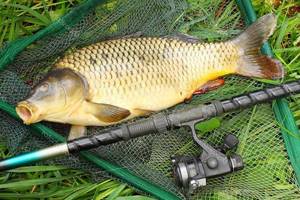
Even when aiming to catch wild carp weighing 3–5 kg, they select equipment that can withstand a heavy load, because along with small fish, real trophies are also caught on the hook. It will be sad and disappointing if a good fish covets the bait, but you can’t get it into the landing net because the rod is too hard or the fishing line is unreliable. Float rods are:
- match;
- plug-in;
- Bolognese;
- flywheels.
Any of the listed rods is suitable as a fishing rod for catching carp in currents or still water, but each of them has its own characteristics. At the same time, there are unifying characteristics and among them we pay attention to:
- system;
- test;
- material of manufacture;
- length;
- price.
Carp are caught on all types of float rods, and the specific choice depends on the fishing conditions.
Flying rods
Fly rod blanks do not have guide rings, and a rubber shock absorber on the tip is used to secure the equipment.
In preparation for fishing for carp, the angler knits several rigs that differ in length and weight, so that while fishing he can quickly change equipment when fishing conditions change. It is inconvenient to knit rigs on a pond, because it will require you to be distracted from your favorite activity, so you need to prepare in advance. Flying rods are:
- telescopic;
- plug-in
Telescopic rods are more convenient for transportation, but create difficulties when preparing for fishing and changing rigs. The length of a telescopic float rod rarely exceeds 7 meters.
Plug-in fly blanks are mounted from several bends inserted into one another and this is more convenient, because in order to shorten the length of the blank it is enough to remove the lower bend. Plug fly rods exceed 7 meters in length, and the fisherman himself selects the required length for the conditions in which fishing takes place.
Plug-in float rods
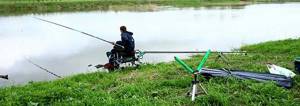
Plug rods also do not have rings, but their design involves the presence of a rubber shock absorber located inside the upper knee. The plastic connector to which the equipment is attached is located on the tip and the plug rubber absorbs jerks of the fish when fishing.
For fishing with a plug on a float, a retractable roller is used, along which the form “rolls back” when fishing, which makes it possible to remove the lower legs. After removing the extra legs, fishing is done as with a short fly rod, and the fish is brought into the landing net.
Bologna rod
This is the simplest and most common float rod, equipped with rings, but it is used to catch small fish at a short distance. The length of the “lapdog” is from four meters or more and it is equipped with small inertia-free reels that simplify the work with the equipment.
Match rod
Match blanks are equipped with guide rings and are used for long-distance fishing with sliding equipment. Such rods have a reel mount, which makes it convenient to fish at a distance of 10 meters or more. The main feature of the “match” is the presence of a sliding float, because it is difficult to accurately set the diving depth over a long distance.
Carp are caught on all types of float rods, taking into account the choice of location, as well as the weight and activity of the fish, but match and plug rods are used most often. The Bolognese fishing rod is too “flimsy” and rough, and the fly rod is not very convenient to handle, especially in those places where you have to catch carp. These are not paid reservoirs, where places for anglers are equipped according to all the rules of comfort, so this factor plays a big role when choosing the type of float rod.
In addition, the match and the plug help to successfully fight and defeat wild carp without breaking the fragile form as a result of careless movement. The fisherman does not know in advance what size fish will be hooked, so he must be prepared for any surprises. A match rod is also convenient in that it is equipped with an inertia-free reel and using its capabilities, in particular the operation of a friction clutch, it is much easier to tire out a trophy fish and bring it into the landing net.
Important! Catching carp is a low-active type of fishing and it is inconvenient for the fisherman to hold the rod in his hands all the time, so in this regard, a plug and match rod is the best choice.
Tackle
For spring fishing for carp, a float rod and a feeder are used. Given the specifics of fishing, the feeder is used most often.
Feeder
The feeder equipment looks like this:
- Rod, 4 meters long, with dough up to 100-120 grams
- Powerful reel, size 5000-5500 with gear ratio 4.1:1 -4.5:1, preferably a baitrunner
- Mono line, diameter 0.3-0.35 mm
- Leash made of mono fishing line, diameter 0.24-0.28 mm
- Hooks 10-12 numbers
Installations are used based on your own preferences, mainly a symmetrical loop or paternoster.
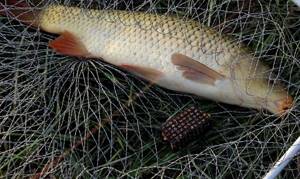
Feeders for the feeder are selected based on the presence and strength of the current. For calm water, cylindrical plastic feeders are used. For fishing in the middle reaches - metal feeders. For fishing in areas with strong currents - weighted metal feeders.
Float tackle
It makes sense to fish with float tackle if the carp stays close to the shore, which is more typical in the first half of spring. In its design it looks like this:
- Rod, 5-6 meters long
- Reel 4000-4500 with baitrunner
- Mono line, diameter 0.28-0.3 mm
- Leash made of fishing line, thickness 0.2-0.22 mm
- Float with long antenna
- Several pellet sinkers
- Hook 12-14 numbers
Which type of float tackle to use depends on the fishing conditions. For example, you can use regular fly rods, provided they are strong enough.
For fishing in the current, Bolognese tackle is better suited. It will help to carefully float the bait downstream, guiding it along the probable locations of the fish.
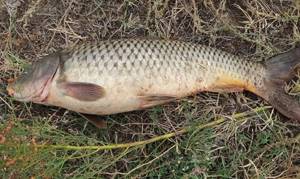
In conditions of limited space, a plug rod is the best solution. In addition, they allow you to silently deliver bait using a special bowl.
When the carp moves away from the shore, match gear is used. They allow you to easily make long casts, which is especially important closer to summer.
Coil selection
With the help of a float match rod, it is easy for an angler to fish not only the coastal zone, but also to fish at a long distance. After the fish has bitten and hooked, the struggle begins, and the inertia-free reel with which the rod is equipped plays a big role in its successful completion. With the help of a friction clutch, it is easier for a fisherman to tire the fish and bring it to the shore at a certain point.
Therefore, when choosing a reel, pay attention not only to the size of the spool, but also to the location and ease of use of the clutch. A large amount of fishing line is not needed, so a spool with a diameter of 3000–3500 will be quite enough. When fishing and especially retrieving trophies, the reel experiences serious loads, so its quality must correspond to the assigned tasks.
Main and leader line
The choice of fishing line for catching carp is determined by the size and weight of this fish, because even small specimens are capable of tearing off a base with a diameter of 0.18-0.2 mm. Definitely, the fishing line must be of high quality and you should not skimp on it, as this can lead to the loss of the trophy.
Considering that casting with a match rod will require 20–40 meters of fishing line, it is better to invest in buying a reliable and proven fishing line. We will not name specific models, but they are known to everyone who fishes with float tackle, and all anglers have heard about the companies Shimano, Owner or Fox. Don’t forget that a supply of main line is also necessary for comfortable landing of fish after hooking, so an extra 30–50 meters on the reel’s spool obviously won’t hurt.
Another important aspect is the color of the main fishing line, because carp have good eyesight and this fish is wary of unfamiliar objects. Colorless fishing line is a universal option, but depending on the color of the water in the reservoir where fishing takes place, green or blue fishing line is also quite appropriate. In carp fishing in the classical way, fishing with orange, red, yellow lines, clearly visible in the water even at dusk, is allowed and even encouraged.
But do not forget that the classic uses a shock leader and icecore, with which the fish is in direct contact, and thanks to the camouflage shade, they do not scare it. The diameter of the base for catching carp is 0.25-0.28 mm and this is enough to hold the fish, as well as to cast to the desired distance. Braided lines are not used when catching carp for match because of their low elongation, and when fishing for large fish at a short distance this is a disadvantage.
The fishing line for leashes should be thinner than the base, this improves camouflage, and when hooked, you will not lose the entire tackle, but only the hook will break. Fluorocarbon leaders have advantages when fishing on rocky bottoms, and due to their high abrasion resistance, they retain their strength. Cutting the leader on shells or rocks on the bottom is not uncommon when catching large fish, so you need to protect yourself from such situations and fluorocarbon leaders will help with this.
Bait, baits
To fish for carp, a large number of different baits of animal and plant origin are used. When choosing a bait, the fisherman has to take into account a number of factors, the main of which are the fishing method, type of reservoir, time of year, place of fishing, time of day, weather, as well as the presence of other types of competing fish, which can not only spoil the mood, but also negatively affect on the catch results.

Animal baits
A crawler or large earthworm is a good bait for catching large carp. It is found in shady places in gardens, parks and vegetable gardens, most often in oily, well-cultivated soil. Reaches a length of up to 20 centimeters and a thickness of 1.0-1.2 centimeters. It is usually red-brown in color, dark on the head side of the body and lighter on the flat tail side. Its presence can be detected by numerous holes in the ground, as well as by piles of discarded earth. Getting this worm with a shovel is a rather difficult and ineffective task, since the burrow goes deep into the ground.
The dung worm is found in heaps of rotted manure, in half-rotten straw, in the ground near barnyards, in greenhouses, greenhouses, in landfills of food and other waste, etc. It has a pungent odor and releases a yellow liquid when pressed. Its usual length is approximately 4-6 centimeters.
The underleaf lives in gardens and vegetable gardens under rotten leaves, among the roots of herbaceous plants, under old wood chips, caked straw, under half-rotten boards and pulled out grass that have been lying on the ground for a long time. In addition, you can find it in garbage dumps and various waste. The body of the worm is red-violet in color, in the tail part it has a lighter shade. It holds weakly on the hook and breaks easily. It is a good bait for catching carp fish.
The white earthworm is found in vegetable gardens, arable lands and meadows. It can also be found at the fishing site - on the shore, in hummocks overgrown with vegetation, or under a layer of old reeds. The color varies, but most often it is grayish-white. Stays securely on the hook. It is one of the best baits for catching carp and some other types of fish. It is most convenient to extract it with a shovel or pitchfork.
Earthworm , which can sometimes be found on roads after heavy and warm rains. Therefore, catching it does not require much effort—you just need to walk around and collect the worm where it crawled out of its burrow. The color of its skin has a pinkish tint. It is a good bait for catching some types of fish, including carp.
The green worm (swamp) lives in muddy banks and floodplain meadows of southern rivers. You can find it with a shovel in the top layer of soil in the roots of plants, as well as under swamp hummocks and in the ground near the water's edge. The body is dark green in color. It stays well on the hook and is one of the best baits used by anglers to catch various types of fish. Large carp mainly bite on this worm.
Maggot is the larva of a large blue blowfly that appears in the spring and usually stays near garbage dumps and rotting waste of meat and fish. She lays eggs on them, which in 4-6 days turn into white, mobile larvae that grow quickly under favorable nutritional conditions.
Plant based attachments
Millet porridge is an excellent bait for catching carp. It is especially good in mid-summer, when aquatic plants become coarser and fade into the background in the fish’s diet. It is prepared in several ways.
A glass of washed millet is poured with two glasses of water (boiled) and cooked over low heat, stirring continuously so that the porridge does not burn. Cook the porridge until it becomes difficult to stir. Then the porridge is removed from the heat and kneaded, gradually adding a tablespoon of sunflower seeds fried and ground in a coffee grinder (to the consistency of ground coffee). The porridge is rolled into balls, which are then placed on a baking sheet and placed in the oven. Bake at a temperature of 80-100°C until a slightly golden brown crust appears. This bait holds perfectly on the hook, as it gets wet quite slowly. Undoubtedly, it attracts large carp, but provided that the balls are not too small (the optimal size is the size of a cherry). Instead of ground seeds, you can add 2-3 drops of garlic juice to the porridge.
Millet porridge can be prepared in another way. A glass of washed millet is poured with two glasses of boiling water. When the porridge is almost ready, put it in the oven and bring it to full readiness for 1 hour at a temperature of 100 ° C. During the simmering process, the porridge is kneaded several times. When the porridge has cooled, it is kneaded and rolled into balls, which are then rolled in ground roasted sunflower seeds, hemp seeds or aquarium fish food.
Bread crust is also a good attachment for carp. You can fish with it both from the top and from the bottom. Squares are cut out from the bottom or top crust of white bread along with the pulp. The usual dimensions are 1.5x1.5 cm with a thickness of about 1 cm. If there are large fish in the reservoir, then even the size of a matchbox. It is better to fish with such a bait in calm water, as it quickly gets wet and is washed away by the current.
Boiled potatoes . Small young potatoes are boiled over low heat. Care must be taken to ensure that it does not crack. Place it on the hook so that the sting just comes out of the potato. The attachment is used for catching large carp. It holds up well in the current.
The dough , even with the addition of cotton wool, gets soggy very quickly and falls off the hook. But there is a way to make the attachment more durable: knead a stiff dough using water or milk. While stirring, add half a glass of roasted seeds. Roll into balls the size of a medium-sized plum (if you make a small nozzle, the small things will quickly eat it up). Then lower the balls into boiling vegetable oil for half a minute. The result is a bait that holds well on the hook and is designed for large carp.
Syrniki . Ground fried seeds, cottage cheese and one raw egg are added to the finished dough. Then a large flatbread is made, which is fried in a frying pan until golden brown. Before fishing, the bait is cut into cubes and put on the hook like a crust of bread. This attachment is quite durable and is used when fishing for carp both in weak currents and in calm water.
Steamed peas . For the attachment, it is better to take non-shelled peas (in the shell). Peas are soaked in the evening. Then it is cooked until half cooked and finished in the oven until cooked at a temperature of about 100°C. The finished peas should be soft and not break into two halves when lightly squeezed. When used as bait, put 2-3 peas on a thin hook, remove the sting and add one maggot or small worm.
Boilies for catching carp
The word "boil" means to cook. This attachment appeared a long time ago, back in the early 70s in England and was most often used when fishing for carp. These are balls consisting of a combination of food components measuring 1.5-3 cm. They include the following components: dry yeast, curdled milk protein (casein), flour, vegetables, vitamins, microelements, flavorings, etc. It is believed that this is an ideal food for fish, since it contains almost all the chemical elements necessary for it.

There is a whole industry for the production of artificial feed, the development of which does not stand still. Chemists introduce new components into boilies, and cooking technology is constantly being improved. The finished mixtures are formed into balls and subjected to heat treatment. The result is a bait suitable, as a rule, for catching large fish - carp, carp, bream. In order to use a boilie as a nozzle, you need to make a thin through hole in it. The mount itself is quite unusual. The following principle is used here: when the boilie is sucked in, along with the flow of water, the hook also enters the fish’s mouth.
The use of boilies as bait has undergone a long evolution. At first it was simply put on a hook, then the thinnest line was placed between the hook and the nozzle, and finally it was replaced with “braid.” Obviously, it is softer and less alarming to the fish. The length of thread between the boilie and the hook is sometimes called "hair". Its length can be from 2 to 5-6 cm, depending on the size of the fish encountered. It is clear that the size of the boilie depends on the size of the hook. The larger it is, the larger the nozzle.
If desired, everyone can make boilies themselves. There are many options here:
Recipe No. 1
- 400 grams of corn flour;
- 200 g soy flour;
- 150 grams of semolina;
- 100 grams of milk protein;
- 50 grams of hemp seeds;
- 50 grams of crushed roasted sunflower seeds;
- 50 grams of salt;
- fruit flavoring.
Recipe No. 2
- 1 kg each of corn, rice and wheat flour;
- 800 g milk powder;
- 1 cup ground birdseed;
- for 1 kg of dry mixture you will need 12 eggs;
- 1 teaspoon of dye;
- 3 tablespoons sunflower oil.
Recipe No. 3
- a glass of corn flour;
- a glass of semolina;
- 50 grams of salt;
- roasted sunflower seeds, crushed – 25 g;
- 25 grams of hemp;
- 2 teaspoons chocolate flavoring;
- betaine – 15 ml.
The prepared mixture is rolled into balls, placed in the oven and baked until done. When they cool and harden, a thin needle is used to make a through hole into which the “braid” is inserted. At the end of the “braid”, so that there is a stop, a tiny piece of a match is tied. Now all that remains is to tie the “hair” to the eye of the hook. The actual nozzle is ready. It can be stored for a long time (for example, in the refrigerator in a box). When used for fishing, the boilie does not soak in water for a long time.
What are the pros and cons of using such an attachment?
In the West, many fishermen fish for the excitement of sport, “carp fishing” - according to the principle: “catch and release”. Indeed, when hooking, using a boilie, the hook usually catches the fish by the lip and injures it less. The “greens” are actively advocating for this in the West. Our angler more often fishes for food, and he doesn’t care whether the bait is on a “hair” or just on a hook.
As for the nutritional attractiveness of boilies, they have no particular advantages when fishing for carp. Rather, on the contrary, the carp clearly preferred a bunch of nimble maggots to an overseas, patented ball. However, in Europe, carp are mainly caught with boilies in special ponds, where they are fed with food components included in the bait (boilie). By the way, there are many dry foods for dogs and cats in the form of granules. It is quite possible to use them when fishing for carp - after all, it is omnivorous.
Floats

The float does not directly contact the fish, but when fishing at shallow depths, the carp will definitely notice a bright spot on the water and will not want to take the bait. Therefore, a float for catching carp should be:
- sensitive;
- hardly noticeable from the water;
- corresponding to the weight of the sinker.
For match fishing, the last condition is especially important, because the sensitivity of the entire equipment and its performance depend on it. The body of the float is slightly elongated, the antenna is thin, and the keel is short.
The weight is selected depending on the weight of the sinker, but the further the distance at which fishing is carried out, the greater the weight of the float and the higher the antenna, this helps to make a successful cast. The exact weight of the float is selected experimentally, after performing several test casts.
Hooks
The choice of hooks for catching carp is determined by the anthropometric data of this fish, as well as the structural features of its mouth part. In the process of feeding, the carp has to split shells and because of this its lips become rough, and the hook must effortlessly cut through the tissue when hooking.

When choosing hooks for catching carp on a float rod, consider:
- size;
- wire thickness;
- weight;
- color;
- width of the hook;
- manufacturing material.
Many companies involved in the production and sale of fishing equipment produce special hooks for catching carp, carp or grass carp on a float. A striking example is the Korda Mixa hook, famous among fans of the flat method, but not everyone knows that it is positioned for fishing with float tackle.
This is a lightweight hook with a wide hook, unnoticeable in the water and very sharp and durable. If you catch carp 15+ on the flat with the help of Mixa, then using float gear is even more convenient. Reliable and high-quality hooks for float tackle are also offered by Owner, Gamakatsu, Korum and even Preston, which is more focused on feeder fishing.
The hook size varies from number 8 to number 16 and there is no need to be afraid to use small hooks. Some fishermen think that in order to catch large fish, such as carp, large hooks made of thick wire are needed. But this is a misconception, because it is more difficult for a thick hook to pierce the lip of a fish, and if it is hooked reliably, then number 12 is enough to carefully fish out a trophy specimen.
If when catching bream it makes sense to use multi-colored hooks, which additionally attract this fish, then to catch carp, take strong nickel hooks or Teflon-coated hooks that do not repel fish.
Feeding
When fishing in the current, you can use bait in a stationary feeder , which lies on the bottom and remains in one place. In particular, such a feeder is a component of a rubber donkey.
You can lower it into the water separately when fishing both with a float rod and with a casting donk.
Another option is to feed with the bait that is used as bait . You can throw corn, peas, pearl barley or boilies into the water in bulk.
The advantage of this method is that such bait does not produce turbidity, which often scares away the carp, while attracting small things . This feeding method is well suited for fishing near the shore at shallow depths. The current will carry away the grains, so you need to regularly add new portions of food into the water.
The next method of feeding is to use multi-component mixtures , which must be filled with water. After this, they can either be thrown into the water with balls, or hammered into a feeder feeder. This feeding method is well suited for any conditions, including fishing at great depths.
The correct concentration for fishing in a particular place determined experimentally. If, when fishing with a bottom with a feeder, the food is washed out of it too quickly after casting, then you need to add more water. When its quantity is optimal, the food will be gradually washed out of it after the equipment falls to the bottom, attracting the carp to the hook with the nozzle.
During the current you need to use a lot of bait , much more than when fishing in still water, since the mixture is quickly carried away by the flow of water. Experienced carp fishermen often throw several tens of kilograms of feed mixture into the water during a couple of days of fishing. And this allows them to achieve excellent results, catching a lot of trophy fish.
Bait for carp and carpHow to prepare bait for carp with your own hands
Groundbaits and baits
Every fisherman knows the rule “what you feed is how you catch it”; it also works when catching carp using float tackle. After spawning, the carp begins to actively feed and is able to eat more than its own weight in food per day. It is difficult to overfeed this fish in the summer, although there should still be reasonable limits.
The area chosen for fishing is fed with balls of pre-prepared bait mixture. When fishing in the current, soil from the reservoir is added to the bait, which weighs down the balls. Adding a dusty small fraction to the bait should seem to attract fish more actively, but small fish, the ubiquitous roach, bream or crucian carp will also come to it.
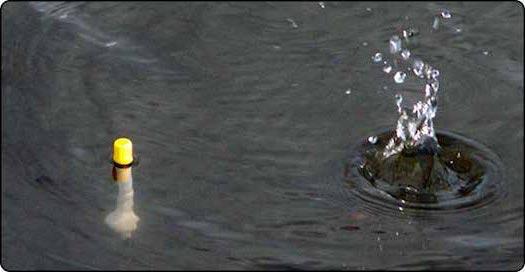
It turns out that the fisherman, having fed the place, does not even realize that all the “goodies” offered to the carp have already been stolen by small fish and there is no point in waiting for a bite. Therefore, a large fraction is added to the bait, which remains at the bottom even in the current. The role of the major faction is performed by:
- pellets 14–22 mm;
- sinking boilies 16–24 mm;
- undercooked peas;
- fermented corn.
The use of dusty boilies is ineffective; they work to quickly attract fish and will become prey for small fish. Store-bought bait, boilies and pellets will be required in large quantities, so for those who are counting money and saving, peas and corn are an excellent alternative.
Peas, in general, are carp’s favorite delicacy, and large fish are drawn to their aroma. Cooking peas is a simple process; the main thing is to ensure that you don’t end up with a soft mass that will be carried around by small fish. The dusting effect of soft peas is undesirable, so they should remain firm. Fermented corn also successfully attracts carp to the fishing point and is used not only as bait, but also as bait.
Fishing tactics
In spring, the behavior of carp changes dramatically, which is explained by warming and the subsequent spawning.
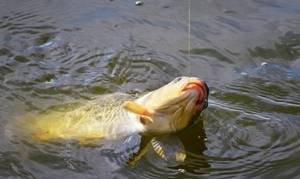
Therefore, depending on the month, fishing tactics will have its own characteristics.
March
In March, even if the ice has already melted, carp can hardly be caught anywhere. The only exception will be the southern regions with a warm climate, where the water has time to warm up to the required temperatures. The activity of the fish is extremely low, it moves little, so it is necessary to fish in deep areas.
Only animal baits are used; there is no particular point in baiting.
April
April is a completely different matter, when the water warms up, the carp approaches the shore and begins to feed intensively before spawning. They fish not only with animal baits, but also with plant baits, and use bait in large quantities.
This period is perhaps the most interesting for those who like to catch carp. First of all, this is a variety of baits, the opportunity to experiment, and besides, the carp stays nearby, which makes fishing much easier.
May
In May, carp begin to spawn. During this period, fishing is prohibited; specific dates are designated for each region. Typically, spawning lasts no more than two weeks, after which the fish return to their usual places in the depths.
Here the best option would be feeder fishing. Over the course of several days, baiting is carried out, which makes fishing more effective.
You can do without attachment by simply feeding several likely areas in advance.
Keep in mind that after spawning the carp is active for about a week, then its bite begins to decline.
